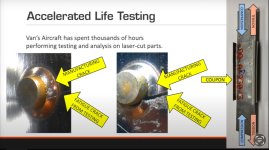Not sure if this statement is true from my experience. There are literally thousands of LCP holes and punched holes in a RV kit. Every time it is burned or punched, there is a potential for error. There is zero chance for a human to catch the defects, especially for the miniscule 3/32 holes. The only way to check them is via a electronic inspection machines and they aren't cheap to operate. These types of machines are used in industrial, agricultural, food processing but you still need specialized tech to program, maintain, etc. So yes, there is an enormous amount of cost for a 100% QC and its not 100% fool proof either.
In the end, it's the builder who has to do the final quality check. Everybody contributes to QC. I found a few major errors in my "pre LCP" kit. This is the same with the big B and A companies too. They handle parts that are shipped across the country, sometimes from a foreign country. I saw parts that are marginal shipped from a foreign country but analysis said it was good, so we used them. Management use the term zero defect as though that actually exists. It's not about catching 100% of everything but the QC system is designed to catch the most errors so that the swiss cheese holes don't line up. If there are something that are found, the damage is gradual enough to issue an SB, or AD, to inspect and to fix. Everything can be fixed. Granted, the most vocal LCP critics have the least amount of rivets but all bad holes can be fixed, and they are being fixed everyday by actual builders.





